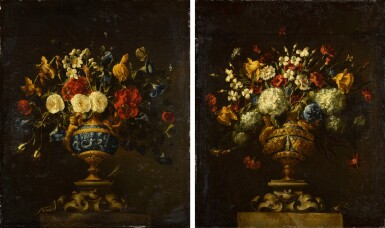
Property from a Spanish Private Collection
Juan de Arellano
A pair of floral still lifes, in lapis and bronze vases on stone plinths | 《靜物畫一對:石基座上的青銅鑲青金石瓶花》
Auction Closed
July 7, 06:31 PM GMT
Estimate
120,000 - 180,000 GBP
Lot Details
Description
Property from a Spanish Private Collection
Juan de Arellano
Santorcaz 1614 - 1676 Madrid
A pair of floral still lifes, in lapis and bronze vases on stone plinths
both signed lower right: Juan de Arellano.
a pair, both oil on canvas, both with extensions of 11 cm. along the upper margin
each: 75.2 x 63.3 cm.; 29⅝ x 24⅞ in.
西班牙私人收藏
胡安・德・阿雷利亞諾
1614年生於桑托爾卡斯,1676年卒於馬德里
《靜物畫一對:石基座上的青銅鑲青金石瓶花》
款識:藝術家簽名Juan de Arellano.(右下)
油彩畫布,一對,兩幅畫上緣均增長11公分
75.2 x 63.3 公分; 29⅝ x 24⅞ 英寸
Inherited from the father of the present owners.
These paintings probably originally formed part of a larger series of floreros or flower still lifes by Juan de Arellano, the pre-eminent painter of flower-pieces in seventeenth-century Spain, painted for the Princes of the Asturias in Oviedo. Apart from the present pair, three other canvas from this group are currently known: two in the Museo de Bellas Artes in Oviedo (figs 1 and 2), and a third formerly in the collection of the famous Scottish collector of Spanish pictures, Colonel William Stirling of Keir (1818–1898) and now in the Masaveu collection in Oviedo.1 All the still lifes are of rectangular format and of very similar dimensions, each having been extended to a more upright format by the addition of extensions of 11 cm. along their upper edges.2The paintings all display exuberant bouquets of flowers in elaborate bluestone (?) vases with fine ormolu mounts and handles in the shape of serpents and herms below the spout, each standing upon identical carved Baroque stone plinths. One of the present canvases, together with one in the Oviedo Museum display an identical carved relief of putti carved in the belly of the vase, while the other Museum picture and the Masaveu canvas share a different fluted decoration. The companion canvas here has a more elaborate decoration of gilt swags on its vase. Both of the canvases here and one of those in Oviedo are signed on the pedestal below the vase, while the other Oviedo Museum picture and that in the Masaveu collection are signed on the dark background lower left.
The differences in the decoration of the urns are most probably purely decorative but may indicate that certain pairs of canvases hung together in the same room. The low viewpoint adopted by Arellano for all of the paintings clearly suggests that they were intended to be seen from below, and therefore most probably their original decorative function was as sobrepuertas (overdoors) or sobreventanas (over windows). Pérez Sánchez speculated that the preponderance of white lilies in the Oviedo pair might have had a specific Marian connotation or iconoography, but the other pictures in the group do not share this characteristic, combining a variety of blooms, among them roses, narcissi, snowballs, carnations, anemones, convolvuli and peonies in their bouquets.
This attention to detail and the notable profusion of insects developed out of Arellano's initial emulation of Flemish models, such as Daniel Seghers, implies an early date of execution. Pérez Sánchez suggests a dating to between 1650 and 1660 for the Oviedo paintings, comparing them to the well-known pair of Flower cartouches in the Prado in Madrid, and the present canvases must surely come from the same period if not the same commission. The quality and colours of these pieces brought Arellano the highest praise from his contemporaries. His earliest biographer, Antonio Palomino de Castro y Velasco, described his workshop in the Puerta del Sol near San Felipe el Real as ‘one of the most famous painting shops in this Court’ and remarked of Arellano that ‘none of the Spaniards surpasses him in eminence on this skill’.3
1 A.E. Pérez Sánchez, Juan de Arellano 1614–1676, exh. cat., Madrid 1998, p. 146, cat. nos 12, 13 and 14, all reproduced in colour. The Masaveu painting was acquired at Christie's London, 14 December 1990, lot 42.
2 The pair in the Museo de Bellas Artes were originally 61 x 56 cm., now extended to 71 x 58 cm. The Masaveu canvas measures 76 x 61 cm with an addition of 10.5 cm. to the top edge.
3 A. Palomino de Castro y Velasco, Museo pictorico y escala optica..., Madrid 1715–24, 1947 ed., pp. 963–64.
You May Also Like










